Yellowstone National Park is one of the most visually stunning and popular places to visit. Millions of people travel yearly to experience its natural beauty and partake in hiking, rafting, and enjoying nature. Known as the first National Park in the world, this National Park is home to various wildlife. Some of the wildlife are deadly, such as Grizzly bears, black bears, gray wolves, and cougars. All these animals prowl along Yellowstone’s grounds, but what about its waters? Snakes are one animal to be aware of lurking in Yellowstone’s waters. This article will discuss the three most snake-infested lakes in Yellowstone National Park to prepare you for your next visit.

Yellowstone National Park occupies space in Wyoming, Montana, and Idaho, although it is not evenly split between all three of these states.
©Jess Kraft/Shutterstock.com
Snakes in Yellowstone
While most people think snakes only exist on land, many varieties prefer the water. Not all snakes that can swim are considered sea or water snakes. There are currently five species of snake living in Yellowstone National Park. Those species are:
- Bullsnake
- Prairie rattlesnake
- Rubber boa
- Common garter snake
- Terrestrial garter snake
Four of these five snakes feel right at home in the water. The four snakes swimming in Yellowstone’s waters are the prairie rattlesnake, rubber boa, common garter snake, and terrestrial garter snake.
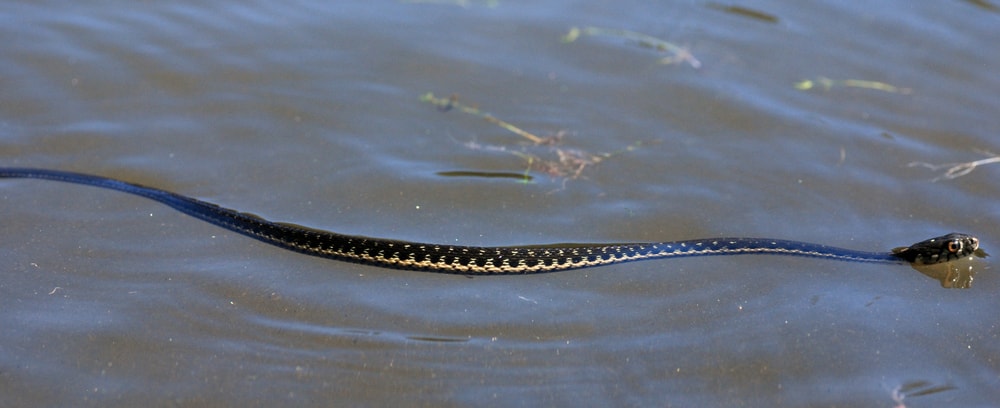
Garter snakes are among the snakes swimming in Yellowstone lakes.
©Jason Mintzer/Shutterstock.com
Identifying Snakes in Yellowstone’s Waters
While none of the snakes in Yellowstone bear the name water snake, they are snakes that can be found in or around the water. Here is some information about the four snakes you should know when enjoying Yellowstone’s pristine waters.
The terrestrial garter snake (Thamnophis elegans) is the most common reptile in the park. It is brownish-green or gray with three light stripes. They frequently inhabit areas near water throughout the entire park and may release musk from glands at the base of their tail when they feel threatened.
The common garter snake (Thamonphis sirtalis) used to be the most common snake but now seems to be on the decline. Dark green or black, with three bright stripes running down its body, this snake gets up to 34 inches long. The common garter snake is typically active during the day and often inhabits areas with permanent surface water.
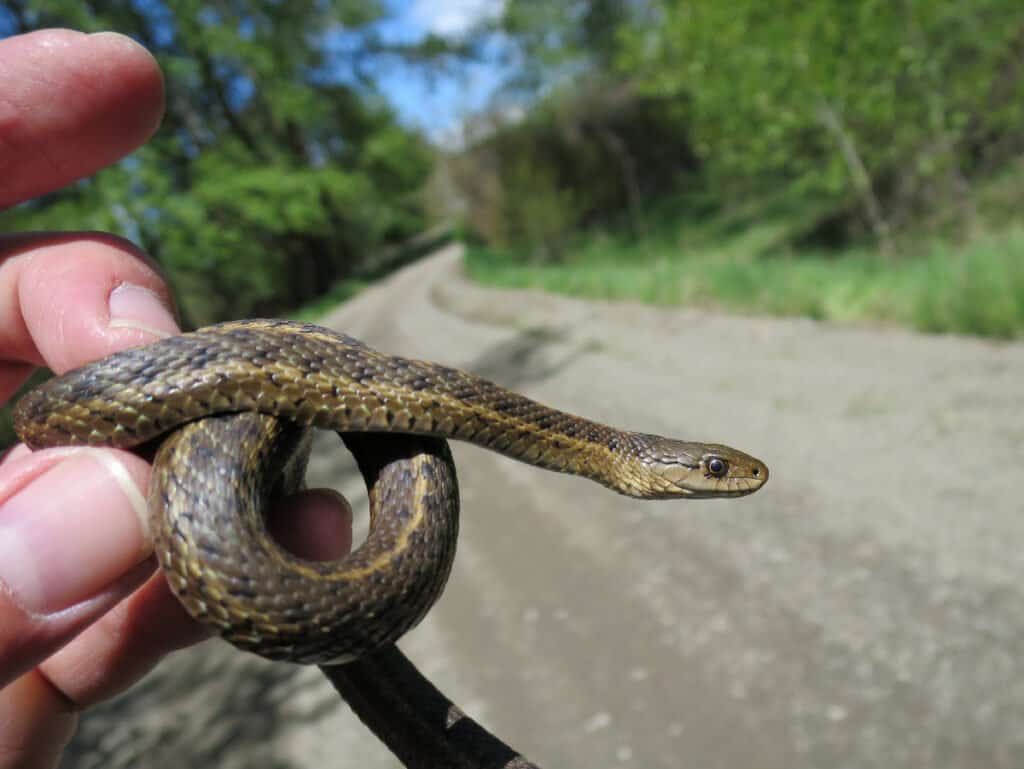
The terrestrial garter snake is the most common reptile in Yellowstone National Park.
©Randy Bjorklund/Shutterstock.com
The prairie rattlesnake (Crotalus viridis) is the only dangerously venomous snake in the park. Growing up to 48 inches, this snake features greenish-grey coloring with dark brown splotches. You can commonly find this snake in the lower Yellowstone River areas of the park.
The final snake is the rubber boa. However, due to its nocturnal and burrowing habits, people do not usually encounter the rubber boa (Charina bottae) in Yellowstone. Usually greenish-brown in color, it features a yellow belly and smooth scales. This snake can get up to 28 inches long. Similarly to the other snakes on the list, you can find this snake near water sources. It typically resides in nearby rocky areas or vegetation bordering the water.
The 3 Most Snake-Infested Lakes in Yellowstone
Yellowstone Lake
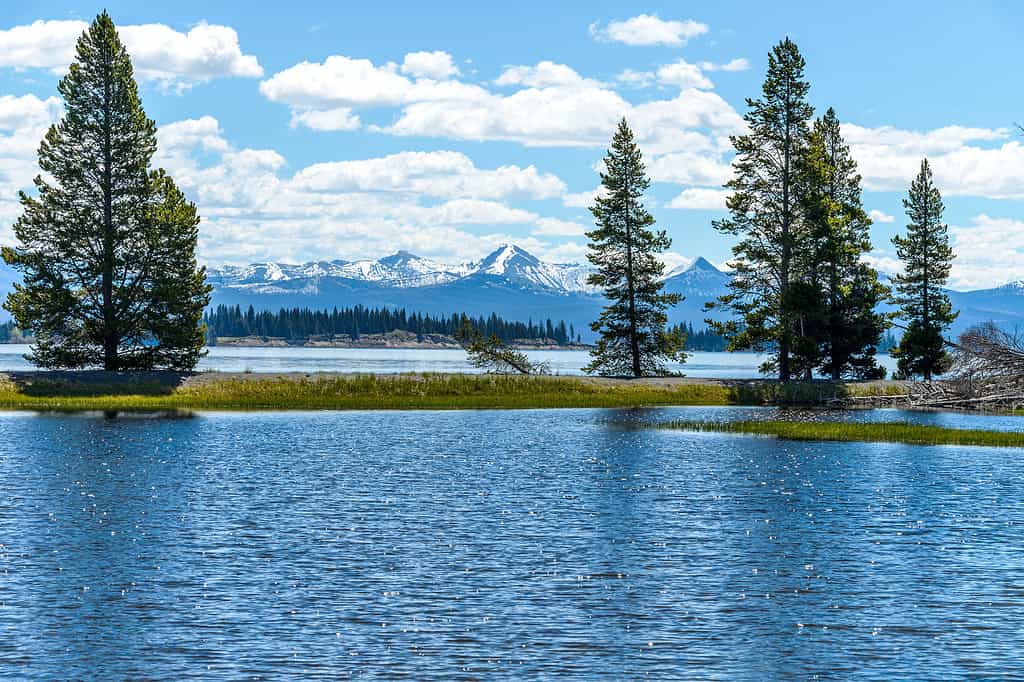
This lake is a popular year-round destination for many people because of its beauty and its activities.
©iStock.com/SeanXu
Yellowstone Lake is the largest high-elevation lake in North America. It is a popular year-round destination for many people. An excellent place for camping, swimming, fishing, and more, it is no wonder that it is a sought-after destination.
Being one of the largest lakes in the park, it is no wonder it has its fair share of snake inhabitants. Another reason that this lake makes it onto the most snake-infested lakes in Yellowstone list is because the Yellowstone River feeds into it. You can find all five park snakes in and around the Yellowstone River.
Since the river flows into this lake, we expect the snakes who inhabit the river to settle in or near Yellowstone Lake as well. Common garter snakes would be the easiest to spot here as they often swim in the water.
Shoshone Lake
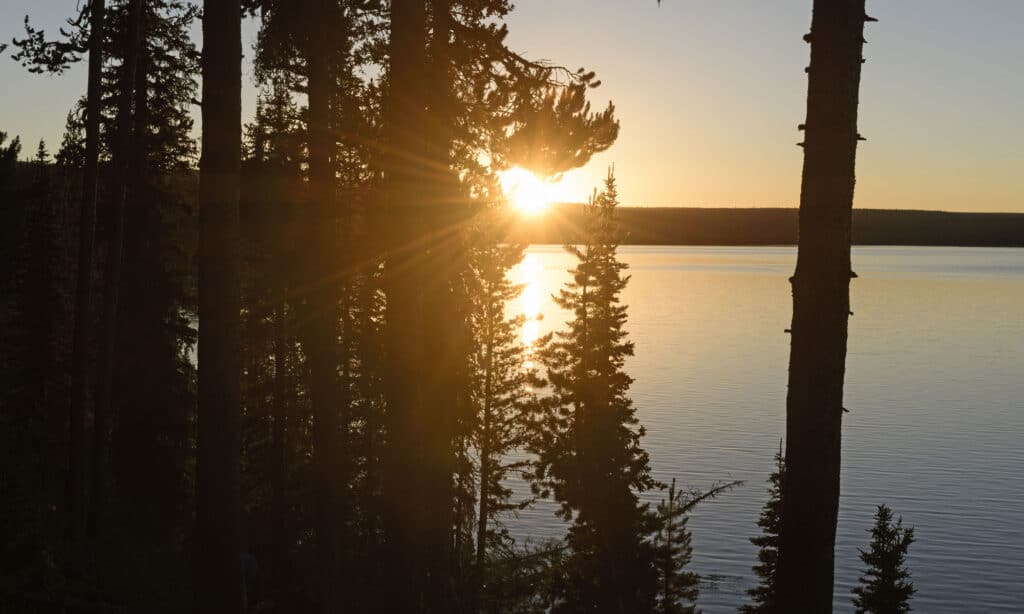
You cannot access Shoshone by road, making it one of Yellowstone’s wilder lakes.
©Wildnerdpix/Shutterstock.com
The second largest of Yellowstone’s lakes, Shoshone, extends across 8,050 acres. The main outlet of this river — the Lewis River Channel — flows into Lewis Lake, the Lewis River, and the Snake River. This lake is 205 feet deep at its maximum depth and contains a variety of fish, such as lake trout, brown trout, and Utah chubs. Additionally, you cannot reach this lake by road, and they do not permit motorboats there.
The wilderness of this lake makes it the perfect home for various wildlife, including snakes. Furthermore, this lake shares an outlet with the Snake River — which the rubber boa has been known to visit infrequently. This lake is also near the Firehole River.
The Firehole River is one of the places you can swim in Yellowstone National Park; it is also home to various snakes. The prairie rattlesnakes and common garter snakes are the most common that you will see here. Shoshone Lake’s proximity also makes it a prime habitat for these snakes.
Grebe Lake
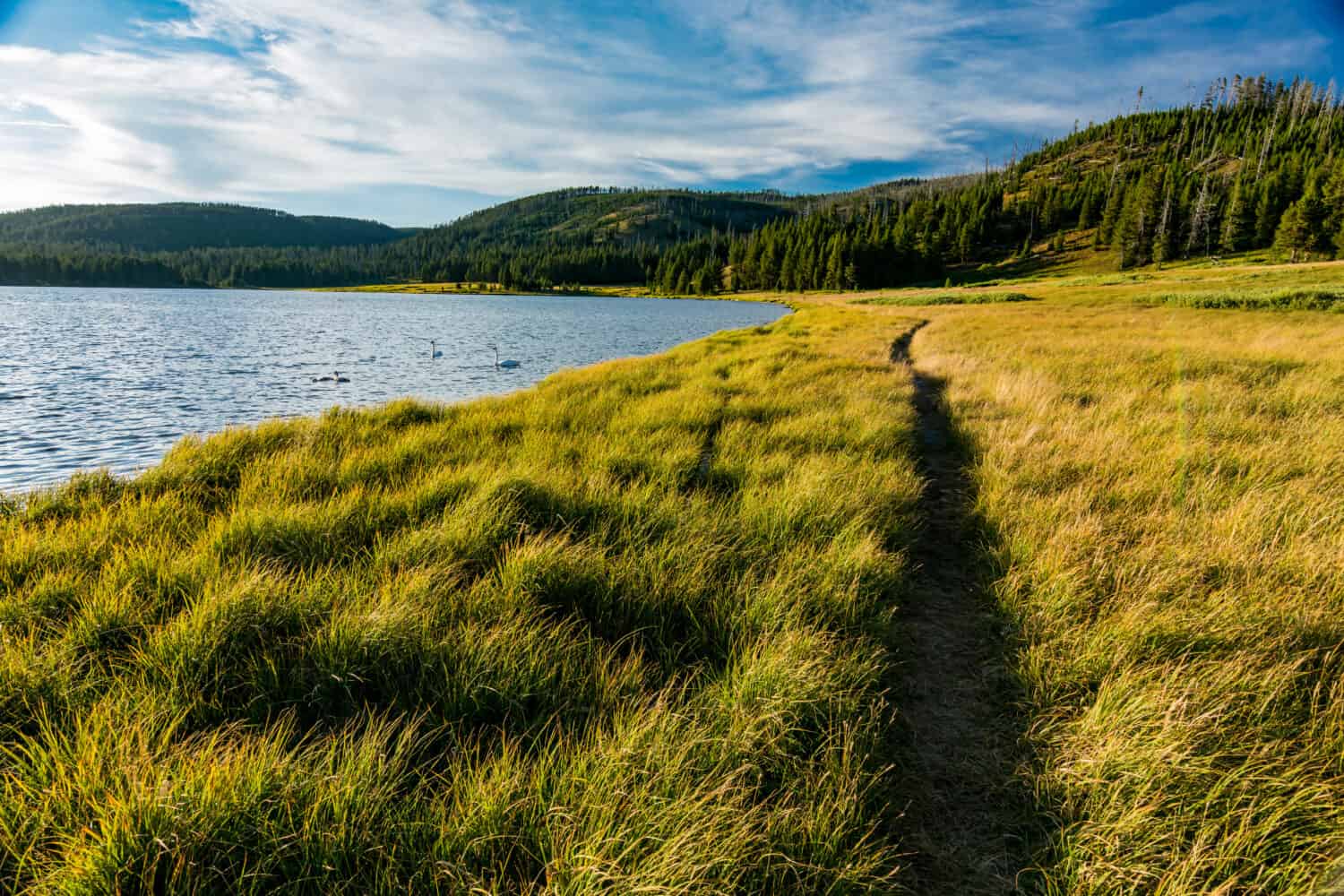
Grebe Lake is known for fly fishing because it contains many arctic graylings.
©Benedikt Juerges/Shutterstock.com
Known for its famous hiking trailhead, Grebe Lake is another of Yellowstone’s beautiful lakes. This lake is also an excellent spot for fly fishing because it contains arctic grayling. This lake makes it onto the most snake-infested lakes in Yellowstone list because of its connection to the Gibbon River.
The Gibbon River begins from Grebe Lake and later flows into Wolf Lake. It is also close to the Gibbon Meadows, which has been a location for rubber boa spottings. The rubber boa is a nonvenomous, nocturnal snake. It is rarely seen because it spends most of its time partially buried under fallen leaves and dirt, hunting prey.
However, this snake has been known to frequent rocks and vegetation near water, and the Grebe Lake’s proximity to both a river and the meadows where these snakes are found makes it a suitable habitat for the rubber boa snake as well.
Other Wildlife in Yellowstone National Park
There is more to Yellowstone National Park than snake-infested lakes. Below, see some more wildlife that resides in this stunning location.
Bison

An estimated 5,000 or more bison live in Yellowstone.
©Ricardo Reitmeyer/Shutterstock.com
The Plains bison (Bison Bison Bison) is one of two species of American bison that primarily lives in North America. A natural population of this bison can be found in Yellowstone Natural Park. There are an estimated 5,000 of them in the park. Weighing 800-2,800 pounds and standing as high as 6 feet tall, these animals are quite large. When visiting, do not approach the bison. Remember, you should observe these wild animals from a safe distance.
Elk
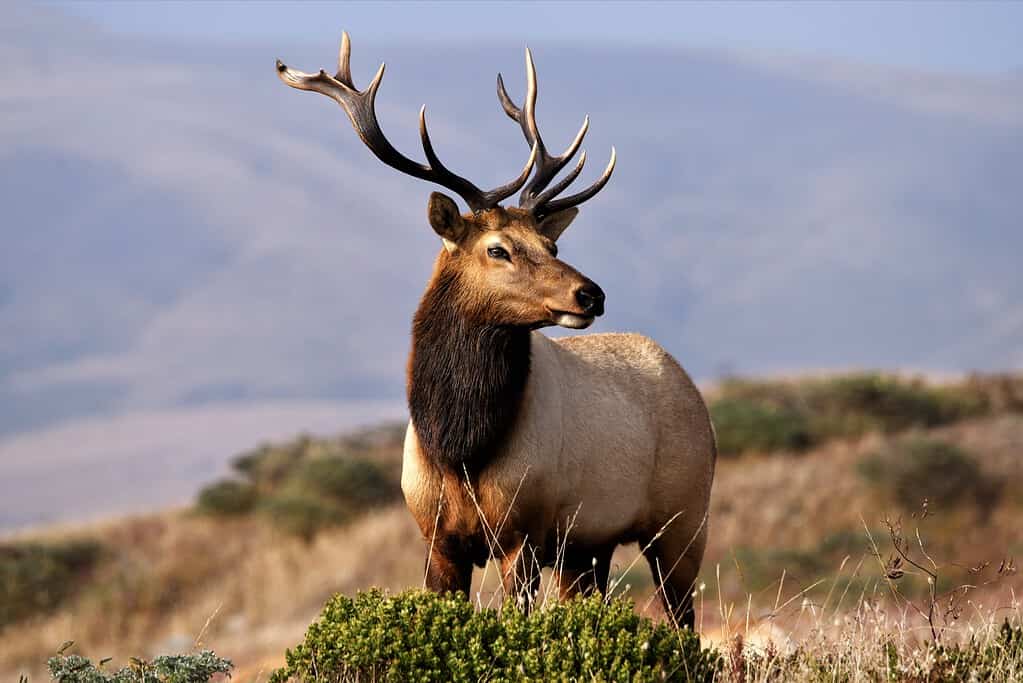
Many people consider Yellowstone to be home to one of the most diverse animal populations in the lower 48 states.
©iStock.com/Eric Clark
Elk (Cervus canadensis) is another common species in Yellowstone National Park. Summer is a much more popular time to see them, where you can expect to see nearly 20,000. The elk is the second-largest wild herbivore after the moose, consuming an average of 20 pounds of vegetation daily. Thousands of elk migrate south from the southern parts of Yellowstone National Park to spend their winters on the National Elk Refuge.
Bears
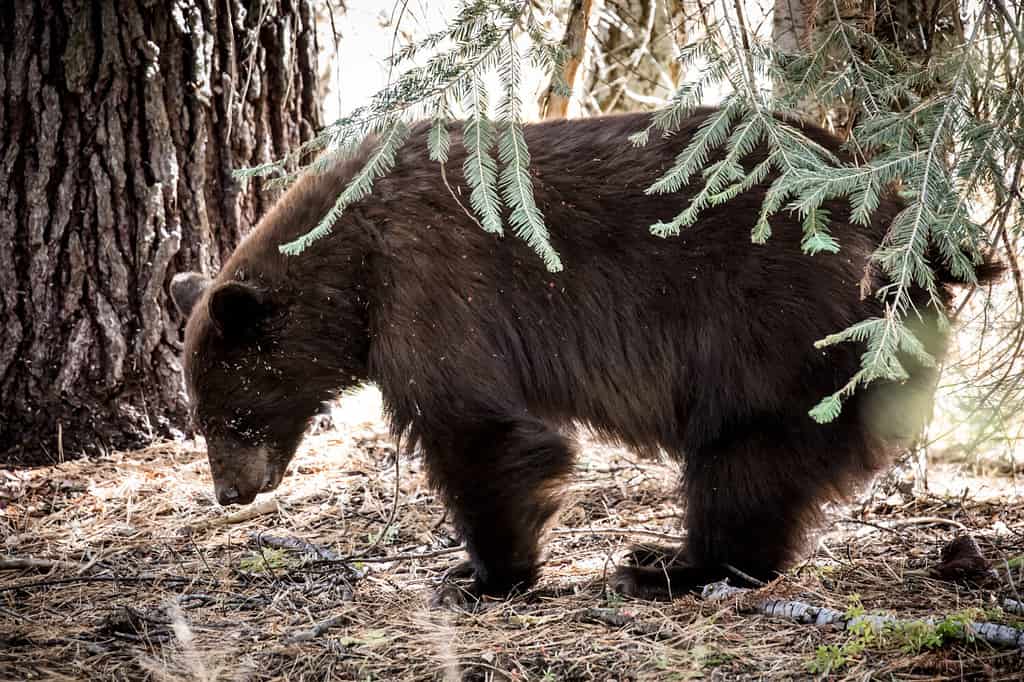
Although Yellowstone is home to black and brown bears, black bears are more common.
©FiledIMAGE/Shutterstock.com
When visiting Yellowstone, you have a chance of spotting either a black or brown bear. Although both are present, it is more common to spot a black bear. The American black bear (Ursus americanus) is the most widespread bear on the North American continent and the most numerous bear species globally. With a population of 800,000, they are a least concern. Researchers believe that because the black bear has such a varied diet, it was able to outlast other types of bears that became extinct in North America.
Additional Questions:
How many lakes are in Yellowstone National Park?
The lakes in Yellowstone National Park are an essential part of the plant and animal communities. Additionally, they are usually protected from environmental stresses in waters outside the park. Yellowstone Lake is the largest high-elevation lake in North America.
There are more than 600 lakes and ponds in Yellowstone National Park. However, out of all those lakes, only 150 are named. There are about 1,000 rivers and thousands of small wetlands. All these water sources found in Yellowstone make up the near-pristine aquatic ecosystems in the United States.
What is the best month to visit Yellowstone National Park?
The most popular months to visit Yellowstone National Park are between April and May or September and October. These are not peak seasons, so you have a better chance of seeing wildlife, and the weather should be milder.
What do I do if I see a snake?
If you see a snake, the best thing to do is to leave it alone. Most wild animals have no interest in engaging with you, so if you step away and give them their space, they will do the same. You should monitor where the snake goes to determine which areas to avoid.
How dangerous are snakes to humans?
While being bitten by any snake is not fun, venomous snakes pose the greatest threat to humans. Out of the 4,000 different species, only 600 are venomous. According to the CDC, “each year, an estimated 7,000-8,000 people are bitten by venomous snakes in the United States, and about 5 of those people die.” Because of medical care, death is uncommon. So there is a risk, but with proper precaution, the danger of snakes to humans is not too high.
Are Yellowstone’s lakes snake-infested?
While snakes can be found in Yellowstone National Park lakes, the term infestation signifies that the amount of snakes would be unusually high. Although snakes are present in the lakes — particularly those mentioned in this article — to argue that any of the lakes are truly snake-infested would be a bit of a stretch.
The photo featured at the top of this post is © iStock.com/SeanXu
Thank you for reading! Have some feedback for us? Contact the AZ Animals editorial team.






